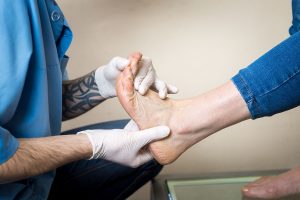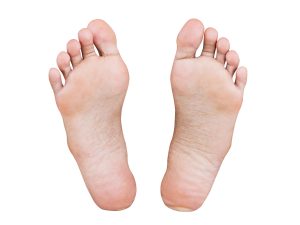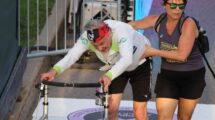Healthy Boomer
By Peggy Edwards
It’s the foundation of your body

Last summer, the big toenail on my right foot cracked all the way down the middle. It was painful; it hurt to wear shoes, and socks would catch on the jagged nail and aggravate the injury. I sighed and thought about how my feet were ageing along with the rest of my body. Finally, I hobbled in to see Sarab Dormani, an RN and Podortho Nurse specialist who owns the Natural Sole Wellness Centre in Ottawa.
Sarab did a thorough intake interview, including a medical history and inspected my feet and lower limbs. She assured me there was no infection nor evidence that an underlying health condition had precipitated the injury. She cut away the problem parts of the damaged nail and skillfully trimmed all of the other nails to prevent the cracking from happening on other toes. She gave me advice on taking care of my feet and stressed the need for daily exercise and a healthy diet to look after both my feet, the rest of my body, and my mind.
Sarab is passionate about her work and the holistic, person-centred philosophy she champions at her clinic, where a professional team offers various services, including nursing foot care, acupuncture, skincare, chiropractic, nutrition and massage therapy.
We had a long talk about feet and foot health. “Feet are the foundation of our body, keeping us upright and moving year after year,” says Sarab. “But too often, we take them for granted until we develop a serious problem. Prevention, especially as you get older, is critical.”
Seventy-five per cent of Canadians will experience foot problems in their lives. But all sorts of foot pain and discomfort can be prevented, eliminated, or made more tolerable by following some simple foot health guidelines and visiting a foot care nurse or podiatrist if you develop foot ailments.

Foot Health Guidelines
Preventing foot ailments
1. Footwear. The size of your feet changes as you grow older, so don’t expect to wear the same size as you did when you were in your thirties! If possible, measure your feet before buying shoes. Make sure your shoes are roomy enough for your toes and will accommodate the normal daily swelling that tends to come with age. Avoid shoes that rub or are too tight— these may restrict circulation or cause abrasive damage to the skin. Wear shoes that support the arches of your feet. If they don’t, use proper insoles. Soles should provide solid footing and not be slippery.
What are the worst shoes? Sorry ladies, they include high heels (you already knew this), flip flops (lack arch support and force your toes to curl, which can lead to issues like hammertoes), ballet flats (no arch support or shock absorption) and mules (lack of ankle support). Heeled mules can leave you more susceptible to sprains, hammertoes, and bunions, thanks to the constant flexing of your feet.
2. Practise good foot care. Wash your feet daily in warm water with a mild soap. Be sure to dry off completely, including between the toes. Moisturize your feet (especially your heels) with a hydrating lubricant, which will help your feet stay smooth and free from calluses and cracking. Once a week, soak your feet in warm water and use a pumice stone or scrub powder on your wet feet to slough away dead skin and reduce corns and calluses. Never shave or cut off your calluses. You may injure the tissue of your feet or get an infection. Cut your toenails straight across and not too short (can cause ingrown toenails).
3. Be active. Keeping active helps keep your feet healthy. It strengthens arches and increases healthy blood circulation in the feet. Include whole-body activities, such as walking or swimming in your weekly routine and practice daily exercises for your feet and lower limbs such as stretching, circling your ankles, raising and lowering your heels, and curling and extending your toes. Try to pick up a marble or dish towel with your toes.
4. Keep blood circulating to your feet as much as possible. Don’t sit for long periods (especially with your legs crossed). If you do have to sit for a long time, elevate your legs and feet, stretch and wiggle your feet and ankles from time to time. Don’t smoke—smoking is a key risk factor for poor circulation in the legs.
5. Check your feet regularly. Even have a member of your family check them. If you have diabetes, mobility problems, arthritis or foot ailments, get a foot check once a year with a foot nurse or
podiatrist. They are also qualified to treat most foot problems. In extreme cases, the special skills of a surgeon may be required.
Some health conditions can cause foot problems. Arthritis and hardening of the arteries (arteriosclerosis) can significantly affect the feet. Gout, caused by an accumulation of uric acid, can cause intense and chronic pain, usually at the base of the big toe. Diabetes can reduce blood circulation in the feet and cause nerve damage (either prickly pain or a loss of feeling). Sarab described how one of her patients felt no pain after stepping on a piece of glass. By the time she got to the clinic, the wound was a stage-two lesion. If she had waited longer, it could have led to limb loss.
“Your feet tell an important story about your past and present health,” says Sarab. “We need to pay attention to them.”
The human foot contains 26 bones, 33 joints, and more than 120 muscles, ligaments, tendons, and nerves. These components work together to support our body’s weight, serve as shock absorbers, maintain our balance, and launch us forward as we walk or run. The arches in your feet are formed by the tarsal and metatarsal bones. They are connected by ligaments and tendons—which
give you the balance and flexibility you need to change direction, walk comfortably, jump and dance. As your feet age, the tendons may stretch out, reducing the height of your arch (fallen arches) and leading to flat feet.
Some people have no problems with flat feet. Others develop pain in the midfoot or all the way up to the hip, knee, and lower back. This is because your feet tend to roll inward without arch support, causing overpronation, which in turn affects your gait and places excessive stress on your ankles and knees, and eventually your hips and lower back. Arch support inserts or orthotics can support or raise the arch.
Daily stretching of the heel and the back of the leg can also help. Research has shown that swollen legs and other foot ailments can increase the risk of falling—something none of us want to do. Using a ground-up approach to prevention and care might be just what you need to keep your feet firmly planted on the ground.
As we age, taking care of our feet could improve our chances of staying on them. Have you had foot problems? How did you deal with them? Write to me at wanderingpeggy@me.com. I’d like to hear and share your story.
Peggy Edwards is a well-known writer and speaker on ageing and health and is a co-author of The Healthy Boomer: A No Nonsense Midlife Health Guide for Women and Men, The Juggling Act: The Healthy Boomer’s Guide to Achieving Balance in Midlife, and Intentional Grandparenting: A Boomer’s Guide, all available at amazon.ca.






